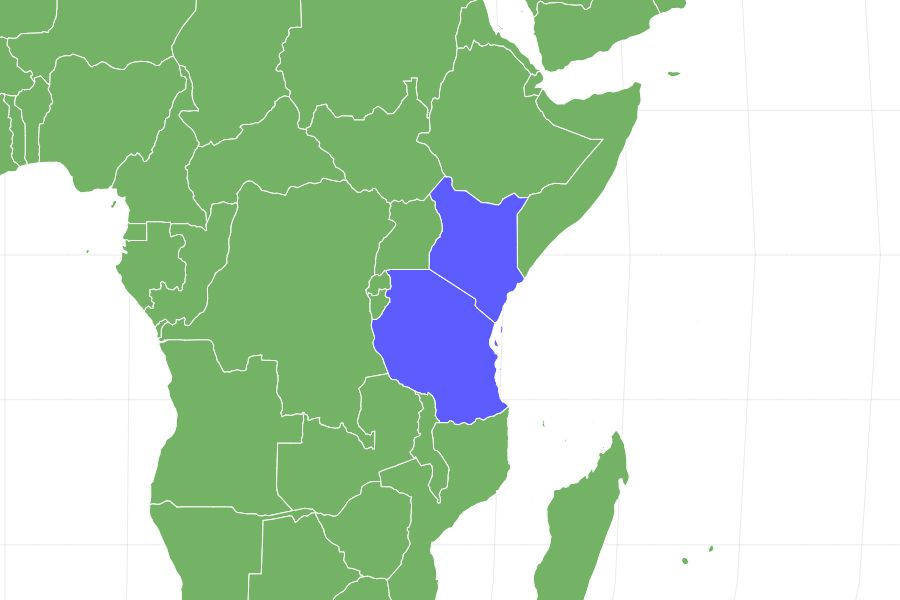Jackson’s Chameleon
Trioceros jacksonii
Have jousting battles with their horns.
Advertisement
Jackson’s Chameleon Scientific Classification
- Kingdom
- Animalia
- Phylum
- Chordata
- Class
- Reptilia
- Order
- Squamata
- Family
- Chamaeleonidae
- Genus
- Trioceros
- Scientific Name
- Trioceros jacksonii
Read our Complete Guide to Classification of Animals.
Jackson’s Chameleon Conservation Status
Jackson’s Chameleon Facts
- Prey
- Insects, centipedes, isopods, millipedes, spiders, lizards, birds, and snails.
- Name Of Young
- Hatchlings
- Group Behavior
- Solitary
- Fun Fact
- Have jousting battles with their horns.
- Biggest Threat
- Natural predators and adult chameleons
- Most Distinctive Feature
- Three horns
- Other Name(s)
- Trioceros
- Gestation Period
- 5-6 months
- Litter Size
- 8-30 eggs
- Habitat
- Woodlands, forests
- Predators
- Carnivorous spiders, birds, snakes, monkeys, shrews, and parasites.
- Diet
- Carnivore
- Type
- Reptile
- Common Name
- Jackson’s chameleon, Jackson's horned chameleon, three-horned chameleon, or Kikuyu three-horned chameleon
- Number Of Species
- 3
- Location
- Hawaii, South-Central Africa
View all of the Jackson’s Chameleon images!
Despite the small size of the dwarf Jackson’s chameleon, it still has the three horns that the species is known for.
Also known as the Kikuyu three-horned chameleon, the Jackson’s chameleon is most commonly known for the three horns that adorn its face. Though it isn’t known for being the largest or smallest of any type of animal, it is one of the few reptiles that experience a live birth (though the hatchlings are kept as eggs within the female for several months). The bright green hue of the male Jackson’s chameleon is quite easy to spot, which is why many people choose to care for it as a pet.
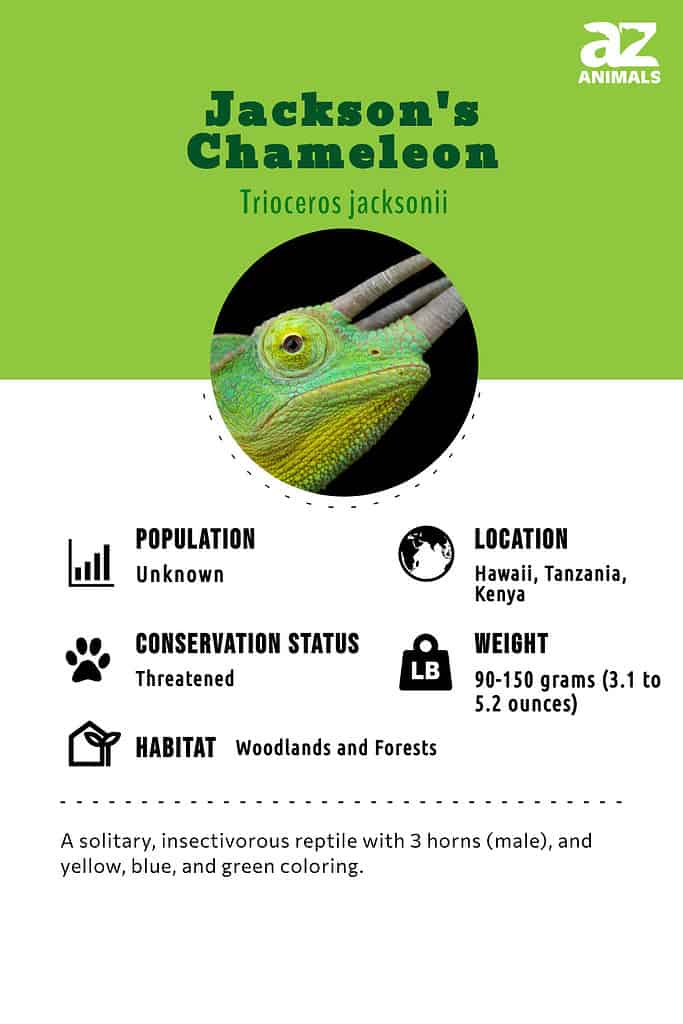
4 Incredible Jackson’s Chameleon Facts!
Here are a few interesting facts about Jackson’s chameleons:
- The price of Jackson’s Chameleon is relatively affordable for most pet owners, only costing about $75 to $175. Factors like their breeding, age, and sex can impact the price.
- Another name for Jackson’s chameleon is the Kikuyu three-horned chameleon.
- Pet care for this chameleon species is rather simple, though it is best to keep them in solitary conditions to avoid aggression and combat.
- There are a total of three subspecies – the yellow-crested Jackson’s chameleon, the dwarf Jackson’s chameleon, and Jackson’s chameleon.
Scientific Name

Jackson’s Chameleons (males) have three horns.
©reptiles4all/Shutterstock.com
The scientific name of the Jackson’s chameleon is Trioceros jacksonii. Though there are no other names for this reptile, it belongs to the Chamaeleonidae family in the Reptilia class. There are only three subspecies of Jackson’s chameleons, which include the:
- Jackson’s chameleon
- Dwarf Jackson’s chameleon
- Yellow-crested Jackson’s chameleon
The word “Trioceros” comes from two Greek words – the prefix τρί- (tri-) and κέρας (kéras). While “tri-” means “three,” “kéras” means horns, which is a clear description of one of the most notable features. “jacksonii,” on the other hand, is a Latinized variation of ornithologist Frederick John Johnson’s last name. At the time, this scientist was the first Governor of Kenya.
Evolution and Origins
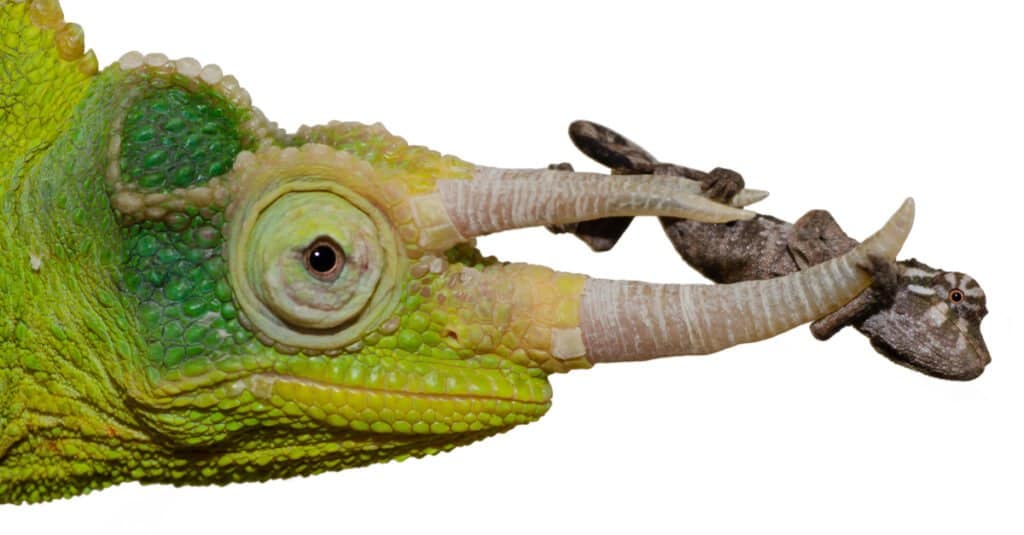
Jackson’s chameleons are millions of years old.
©Jason Mintzer/Shutterstock.com
The evolutionary history of the Jackson’s chameleon is a fascinating topic that has intrigued scientists and researchers for many years. This species, which is native to East Africa, has undergone several significant changes over time.
One of the most interesting aspects of the Jackson’s chameleon’s evolution is its ability to change color. This adaptation allows it to blend in with its surroundings and avoid predators. Through genetic mutations and natural selection, this trait evolved over time to become more refined and effective.
In terms of fossil evidence, there are limited findings related specifically to the Jackson’s chameleon. However, studies have shown that similar species existed as far back as 26 million years ago during the Oligocene period. These ancient relatives were found in Europe and North America.
Overall, while there may not be extensive fossil evidence directly related to the Jackson’s chameleon itself, it is clear that this species has undergone a remarkable journey throughout its evolutionary history.
Appearance
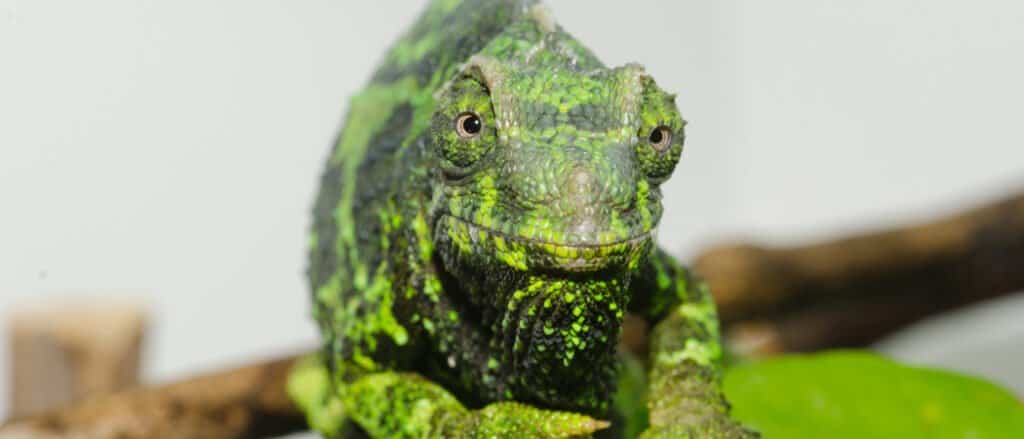
Female Jackson’s Chameleons do not have horns.
©Jason Mintzer/Shutterstock.com
One of the most notable features of Jackson’s chameleons is the bright green hue, which is more common among males. To accent their vibrant color, they also have blue and yellow markings around their face and feet. The female, on the other hand, is not quite as vibrant.
The easiest way to tell the difference between the female and male Jackson’s chameleon is the horned face. Only the males have the three horns that this reptile is known for. This horned look is typically used to defend the territory of the male, much like the purpose of the horned (but extinct) triceratops. Even the rhinoceros only have 1-2 horns, though some may have three.
On average, these reptiles can weigh up to 150 grams when they reach their full size, which is slightly more than a baseball. They are about 9-13 inches long. Males are often larger than their female counterparts, but the yellow-crested Jackson’s chameleon can grow to be 15 inches long. The dwarf Jackson’s chameleon is typically much smaller.
Behavior
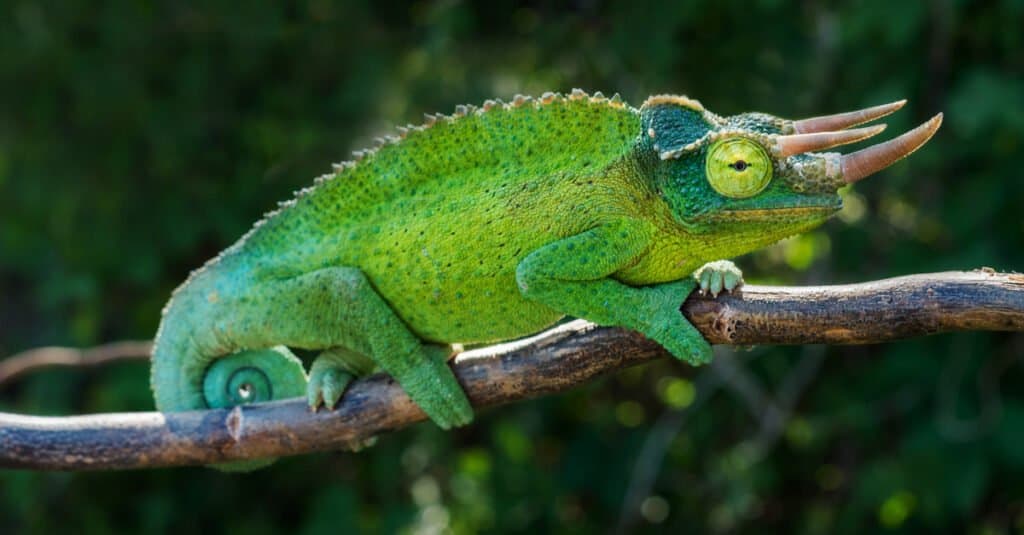
The Jackson’s Chameleon is incredibly slow, leaving it vulnerable to predators. However, its horns are helpful in warding them off.
©Jan Bures/Shutterstock.com
The grouping structure of this reptile is rather unique. If kept as a pet or even in the wild, one of these reptiles is content to roam, hunt, and live alone. They come at a price of $75 to $175 in stores. However, within a family unit, the organization is much different. With their social structure, they have the freedom to keep space from each other when they want to have it, allowing them to consistently communicate. They require special care to keep them happy and healthy when in captivity, and they must be allowed to become comfortable before their personality shines.
It is not advised to keep these types of chameleons in a tank together, as they will often fight over the food, space, and where they like to bask in the light. This pairing can lead to severe injuries or fatalities. The only time that these reptiles typically become aggressive is when their freedom to live as they’d like is impeded, including their access to food and water.
On their own, the Jackson’s chameleon can be quite even-tempered, though they lean more towards a shy personality. They are much less timid than other wild animals, making them easy to keep as pets. They are typically active during the day and will enjoy the sunlight between hunting sessions.
Habitat

Jackson’s Chameleons live in Hawaii, Kenya, and Tanzania.
©Matt Jeppson/Shutterstock.com
The first Jackson’s chameleons were found in Kenya and Tanzania, and two of their subspecies are still found broadly throughout the area. By the early 1970s, they became an invasive species in Hawaii as well, allowing them to spread their population rapidly. Even though it is only found in the wild in Hawaii, Tanzania, and Kenya, they still have thrived.
In the wild, these reptiles prefer to live in woodlands and forests, typically finding a home at altitudes of no less than 1,600 meters. Some will travel as high as 2,440 meters in Kenya and Tanzania, allowing them to reach the sunlight when temperatures reach about 16–27 °C (61–81 °F) during the daytime. In some cases, the reptile is found in wooded areas in the suburbs of Nairobi.
The Jackson’s chameleons that live in Hawaii find themselves at altitudes of 100 to 1,000 meters. Instead of inhabiting wet and shaded areas.
Diet
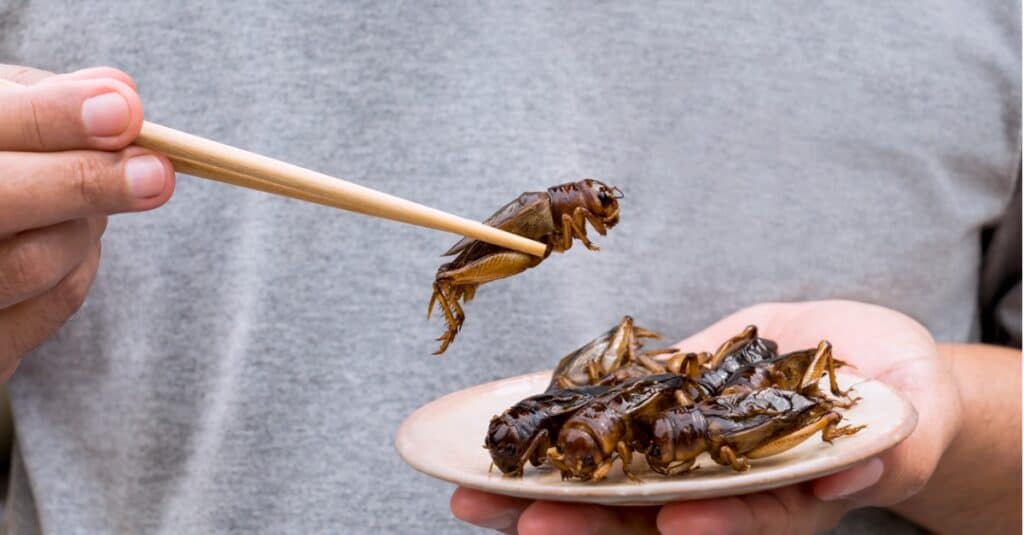
Bon appetit! Jackson’s chameleons find crickets delicious!
©iStock.com/ARISA THEPBANCHORNCHAI
Jackson’s chameleons are mostly insectivores, and their diet consists of a variety of insects, such as spiders and flies. In the wild, they primarily feed on crickets, grasshoppers, flies, moths, and other small invertebrates that they can find crawling or flying around their habitat. They will eat the leaves of plants such as ficus and hibiscus only rarely.
Jackson’s chameleons rely heavily on their eyesight to locate prey. Their eyes move independently from each other, allowing them to scan for food in different directions at once. Once they spot a potential meal, they use their long tongue to snatch it up quickly with lightning-fast reflexes.
Although Jackson’s chameleons are not active hunters like some predators that stalk their prey before attacking them. However, they do have a hunting strategy known as ambush hunting. Remaining still for extended periods while waiting for unsuspecting prey to come within striking distance allows them to conserve energy while maximizing the chances of catching something nutritious.
In captivity, where food is readily available but may not be nutritionally balanced, provide appropriate supplementation, such as calcium-dusted insects. As always, seek advice from a veterinarian before giving supplements to your pet.
Predators and Threats

Jackson’s Chameleons have to watch out for snakes, their main predator.
©Janelle Lugge/Shutterstock.com
As solitary as the Jackson’s chameleon can be, it still has its share of predators. Due to their slow speed, they are rather easy to catch. However, their horns allow them to put up quite a fight. Since they are protected from illegal sales in most regions, there is little threat from humans.
What eats Jackson’s chameleons?
This reptile is up against many predators, and its slow speed does not help with its defense at all. Animals that eat the Jackson’s chameleon while they are young include some species of spiders, birds, snakes, and adult chameleons of other species. The adults are hunted by snakes, monkeys, parasites, birds, and shrews as well.
What do Jackson’s chameleons eat?
Jackson’s chameleons have a rather broad diet of insects, including crickets, silkworms, roaches, mealworms, grasshoppers, and fruit flies.
Reproduction and Life Cycle
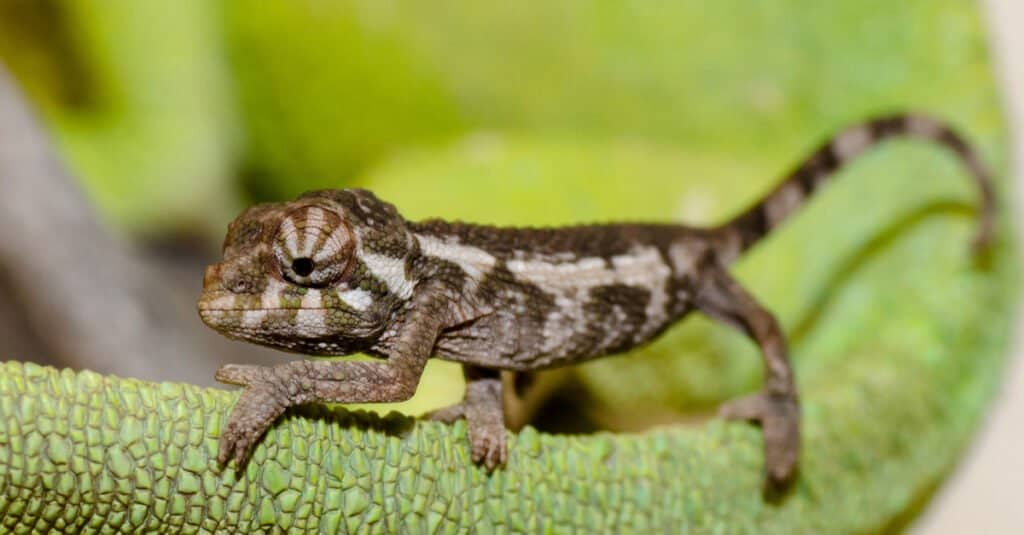
Jackson’s Chameleons are born in litters of 10-20 usually, but there can be as many as 40!
©Jason Mintzer/Shutterstock.com
Mating between the female and male Jackson’s chameleon is unique. The only time that these reptiles tend to come together is to mate, communicating through a series of physical gestures. The male will use head bobbing, though he’ll also flex his neck and show his open mouth. The female, in response, will show her acceptance of these movements by becoming bright green along her scales. This communication has been praised by scientists as a way to show the intelligence of the species.
Typically, this mating can result in 8-30 eggs (though it can be up to 40 in larger litters), which are kept within the female’s body for about three months. They have a live birth, though there are recorded instances of being born within a soft membrane. Females often reproduce seasonally, which means that a new litter is born every 6 months.
The young are typically 52-55 mm long at birth, though about half of their size is their tail. Rather than being green or blue, the young are black, white, and grey. There is no weaning period, and the young can catch live prey from birth. It only takes about 5 or 6 months after birth for these chameleons to reach sexual maturity.
Population and Conservation

Jackson’s chameleon is thriving in Hawaii.
©Movingsaletoday edited by Muhammad, Public domain, via Wikimedia Commons – Original / License
The current population of Jackson’s chameleons is unknown, but they are a threatened species due to several factors. One major threat to their existence is habitat loss and fragmentation caused by human activities such as deforestation, agricultural expansion, and urbanization. This has resulted in the destruction of their natural habitats, which makes them vulnerable to predators and other threats.
Another significant threat facing Jackson’s chameleons is the introduction of non-native predators like rats and cats into their ecosystems. These invasive species prey on young or adult chameleons, reducing their numbers significantly. Additionally, illegal collection for the pet trade has also led to declining populations.
Conservation efforts have been put in place to protect these unique creatures from extinction. Some measures include setting up protected areas where they can thrive without disturbance from humans or introduced predators; implementing strict laws against poaching and trading; educating local communities on the importance of preserving endangered species like Jackson’s chameleon; and conducting research aimed at improving our understanding of these animals’ biology, behavior patterns, distribution range among others.
Overall, there is still much work needed towards conserving this iconic reptile so that future generations can enjoy its beauty as well as preserve biodiversity in our ecosystems.
View all 36 animals that start with JJackson’s Chameleon FAQs (Frequently Asked Questions)
Are Jackson’s chameleons carnivores, herbivores, or omnivores?
Jackson’s Chameleons eat insects primarily but are occasionally carnivorous.
Where do Jackson's Chameleons live?
Chameleons live in dense forests and woodlands in south-central Africa and Hawaii.
Are Jackson’s chameleons friendly?
Usually docile with human interaction, Jackson’s Chameleons can be aggressive with other reptiles and chameleons.
Are Jackson’s chameleons aggressive?
Generally speaking, Jackson’s Chameleons will only become aggressive when two or more are kept in the same tank and get territorial over a food source.
Do Jackson's chameleons change colors?
Color can vary from green to yellow, blue, or orange depending on the individual and mood. Chameleons can change color quickly depending on temperature, health, and mood.
How much are Jackson’s chameleons?
Depending on the animal’s age, sex, and lineage (for example, captive-bred or wild-caught), the price can range between $75 and $175. Today, the majority of Jackson’s chameleons sold on the market are captive bred.
Thank you for reading! Have some feedback for us? Contact the AZ Animals editorial team.
Sources
- Cabi / Accessed August 16, 2021
- Wikipedia / Accessed August 16, 2021
- The Spruce Pets / Accessed August 16, 2021
- Everything Reptiles / Accessed August 16, 2021
- Chameleon Academy / Accessed August 16, 2021
- BioWEB / Accessed August 16, 2021
- The Animal Facts / Accessed August 16, 2021
- Reptiles Magazine / Accessed August 16, 2021

